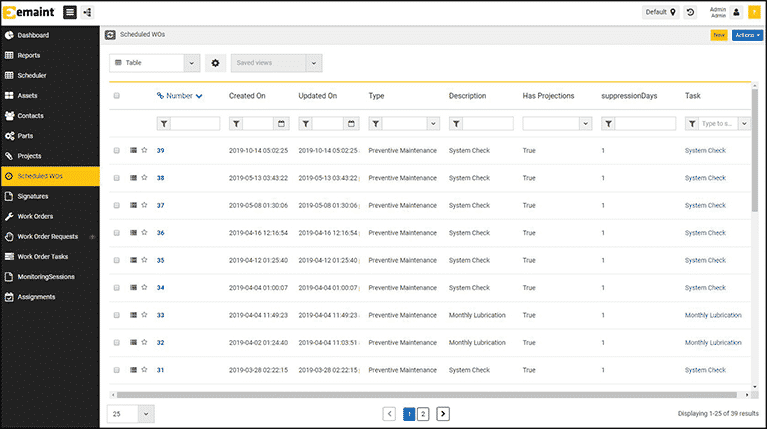Designing a preventive maintenance program is a significant step toward preventing failures, reducing costs, and more. Once an organization has created a preventive maintenance program, there needs to be a plan in place to review and reassess what is working, what isn’t adding value, and what further changes are needed. Instead, many organizations continue down their original path. Then, they are blindsided when failures occur, or they do not reap the full benefits they expected.
What Is a Preventive Maintenance Program?
Preventive maintenance is regular, planned maintenance that’s scheduled according to time or use. For example, a routine maintenance task might be scheduled for the first day of every month, or after a certain number of production cycles.
To balance the risk of failure with the time and costs of maintenance, preventive maintenance programs should be periodically reviewed based on failure history and performance analysis. This is called preventive maintenance optimization. It is a method of continuous improvement, aiming to increase the effectiveness and efficiency of maintenance activities. A successful preventive maintenance program has numerous benefits:
- Increased cost-effectiveness
- Improved reliability
- Increased machine uptime
- Enhanced organizational understanding of managing risk
- Better clarity around maintenance tasks
- Focused use of resources
How to Start a Preventive Maintenance Program
Wondering how to develop a preventive maintenance program? One way to keep it from being overwhelming is to start small, get some findings and results, and then expand. You don’t need to cover everything at once. Start with some of the assets most critical to your organization’s production and goals. When creating the complete list of preventive maintenance tasks to perform, as well as identifying how often to perform them, consult both your maintenance history data and OEM recommendations.
Implementing a pilot program and proving that it can provide some substantial ROI gives you a solid foundation to build on. Collect feedback from your team to identify what is working well and what isn’t.
Optimizing Preventive Maintenance Program Schedules
There are three popular approaches for optimizing preventive maintenance schedules:
- Reliability-centered maintenance (RCM)
- Failure reporting, analysis, and corrective action system (FRACAS)
- Judgment-based approach
Reliability-Centered Maintenance (RCM)
This approach works to ensure systems continue to do what is required for operations. The goal is to implement a unique maintenance schedule for each critical asset within a facility or organization. In his book RCM2, the late John Moubray characterized reliability-centered maintenance as a process to establish safe minimum levels of maintenance.
According to ReliabilityWeb.com, a program must meet these four basic principles in order to be recognized as reliability-centered maintenance:
- The program is scoped and structured to preserve system function
- It identifies how functions are defeated (failure modes)
- It addresses failure modes by importance
- For important failure modes, it defines applicable maintenance task candidates and selects the most effective one
In addition, there are four phases of an RCM project, according to ReliabilityWeb:
- Decision: Justification and planning based on need, readiness and desired outcomes
- Analysis: Conduct the RCM study in a way that provides a high-quality output
- Implementation: Act on the study’s recommendations to update asset and maintenance systems, procedures, and design improvements
- Benefits: Measure the improvements and identify opportunities to further improve
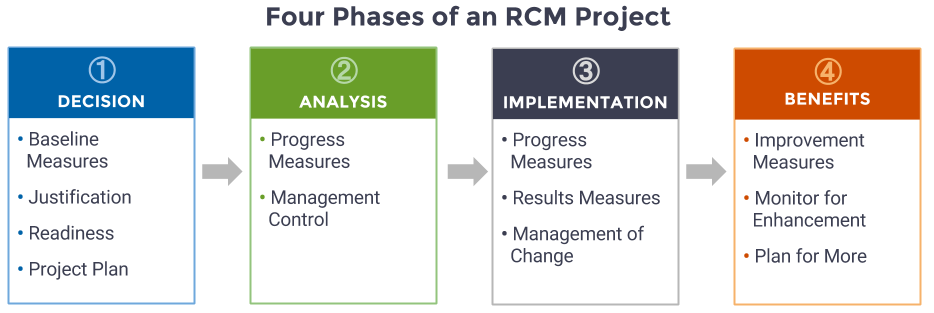
Image courtesy of ReliabilityWeb.com
This approach is a multi-faceted process that requires time, effort, and buy-in from your maintenance team, leadership, and other stakeholders. Thus, it is best deployed to improve efficiency for large-scale, capital projects or for critical equipment.
Failure Reporting and Corrective Action System (FRACAS)
A failure reporting, analysis, and corrective action system (FRACAS) is a more rapid approach to optimize PMs, and does not require extensive planning and decision-making to assess a PM program. FRACAS is a system that establishes a procedure for reporting, classifying, analyzing failures, and planning corrective actions in response to common failures. It identifies the root causes and failure analyses to help organizations implement the best solution to prevent or predict the issue from occurring time and time again.
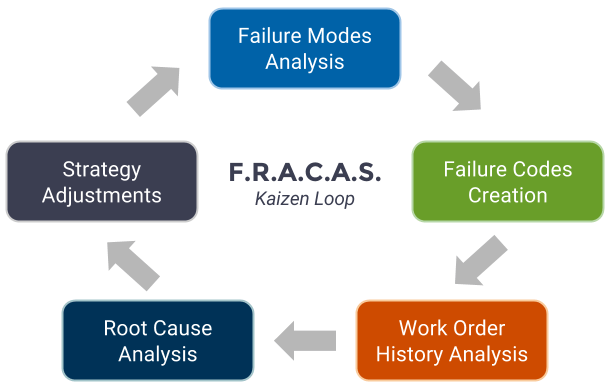
FRACAS consists of:
- Failure Reporting: Asset or system failures are formally reported through a Defect Report, Failure Report or within a Computerized Maintenance Management System (CMMS).
- Analysis: Perform analysis in order to identify the root cause of failure.
- Corrective Actions: Identify, implement and verify corrective actions to prevent more repetition of the same failure.
Common outputs from FRACAS include key performance indicators such as mean time between failures (MTBF), mean time between repairs (MTBR), mean time to repair (MTTR), reliability growth, and failure/incidents distribution by type. The FRACAS model provides the information needed to support root cause failure analysis (RCFA) efforts.
Judgment-Based Approach
This process involves consulting the maintenance team and system engineers to develop a plan based on how they have seen the equipment operate and respond to the existing preventive maintenance program schedule.
The judgment-based approach is not as data-driven as the other methods and will not produce the same data and indicators of performance. However, in some cases and for some pieces of equipment, the time and effort required to collect and track data are not necessary or justified. Judgment-based preventive maintenance is best for assets that are less critical to production or that are inexpensive to repair or replace.
How a CMMS Can Help a Preventive Maintenance Program
Preventive maintenance scheduling software is a helpful tool for scheduling, tracking, and analyzing your efforts.
Automate Preventive Maintenance Processes and Procedures
A CMMS offers automation tools to help reduce missing scheduled work and equipment failures, making your preventive maintenance program as efficient and streamlined as possible. Preventive Maintenance Task Generation, Preventive Maintenance Scheduling, and Inspections features facilitate continuous improvement and support for your preventive maintenance program.
- Preventive Maintenance Task Generation: Use calendar- and/or meter-based preventive maintenance tasks for all assets. These include detailed descriptions with how-tos, guidelines, and other information vital to effectively performing the work.
- Preventive Maintenance Task Schedules: Coordinate labor resources and parts needed to complete work and automatically generate preventive maintenance tasks based on usage or on a daily, weekly, or monthly basis.
- Inspections: Record inspections accurately and generate corrective work orders when equipment inspections fail.
A CMMS completely automates the failure reporting step in the FRACAS method. You can also leverage a CMMS to perform root cause analysis and deploy corrective actions.
Track and Analyze Preventive Maintenance Program Schedules
Both reliability-centered maintenance and FRACAS require considerable tracking and analyzing of preventive maintenance processes. With eMaint’s reporting and dashboard tools, organizations can consistently document work order history, failures, costs and trends. With a few clicks of a mouse, organizations have access the data to perform the analyses that both RCM and FRACAS requires.
- Reports: Build reports that can be automatically updated with your organization’s most important KPIs and keep all critical data in one place. You can also automatically generate and email reports to anyone in your organization.
- Dashboards: With your CMMS data, generate dashboards and associated graphs on total downtime by critical asset, MTBF, wrench time percentage, and more. This will help your organization get a better understanding of how equipment is performing and how to improve processes.
eMaint Clients and Process Optimization
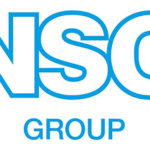
Nippon Sheet Glass (NSG) Group is one of the world’s leading manufacturers of glass and glazing systems. Nine ISO/TS 16949 compliant plants across NGS Group’s North American operations use eMaint.
Within the system, NSG Group set up a template to standardize across all locations to effectively look at performance and analyze key metrics, including leading and lagging. Completion rates for preventive maintenance are an NSG Group leading metric because of how it can impact operations.
KPIs are recorded and tracked on a daily basis. The team developed a Metrics Center tab on their Dashboard, which offers live data on preventive maintenane completion rates per Master Asset (Production Line) asset. The team also tracks each location’s performance to develop benchmarks and a scorecard that supports corporate goals of continuous improvement and reduction of waste.
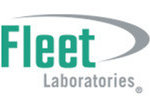
C.B. Fleet Laboratories is a leading manufacturer of personal care and over-the-counter products, specializing in feminine hygiene, gastrointestinal products, and infant care.The team kicked off implementation by interviewing mechanics to collect their insights into daily activities and identifying which aspects of work were the most challenging.
Five key pillars were identified as the focus for revamping processes: people, material management, workload management, basic care and, reliability. The company has reported that nearly every aspect of business is measured and reported to improve accountability, transparency and productivity within the company.
C.B. Fleet’s use of eMaint led to a 50% reduction in reactive maintenance and a 35% decrease in reactive maintenance labor hours.
An effective preventive maintenance program is about performing the right work, at the right frequency, the right way. A few KPI improvements eMaint clients have experienced thanks to leveraging preventive maintenance include:
- 30% reduction in corrective maintenance
- 20% to 80% increase in planned maintenance percentage
- 77% increase in preventive maintenance compliance
Want to learn how eMaint can improve your organization’s preventive maintenance program? Get your free trial started today or click here for pricing.


